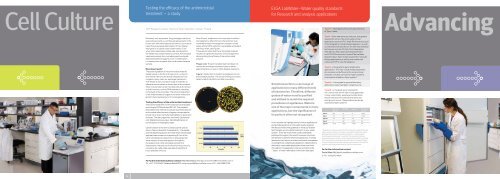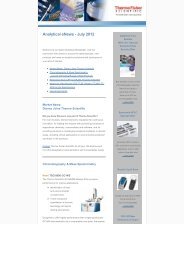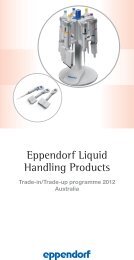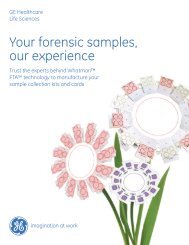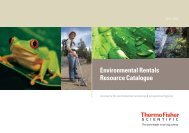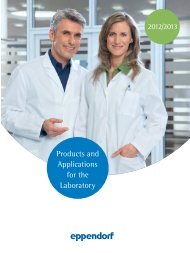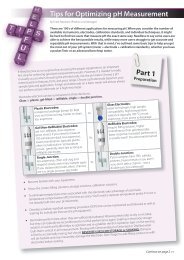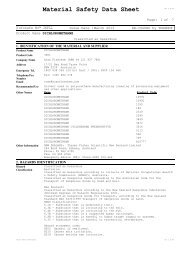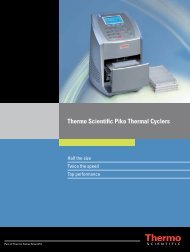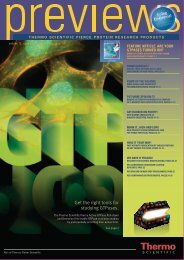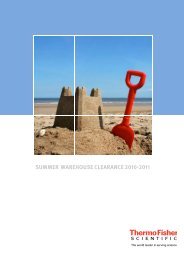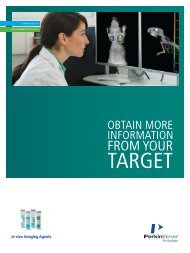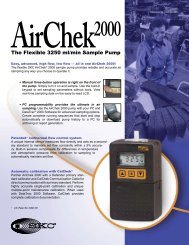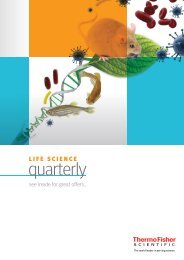Issue 1 - Thermo Fisher
Issue 1 - Thermo Fisher
Issue 1 - Thermo Fisher
Create successful ePaper yourself
Turn your PDF publications into a flip-book with our unique Google optimized e-Paper software.
Cell Culture<br />
Testing the efficacy of the antimicrobial<br />
treatment – a study<br />
ELGA LabWater–Water quality standards<br />
for Research and analysis applications<br />
Advancing<br />
LCP Research Group, <strong>Thermo</strong> <strong>Fisher</strong> Scientific, Vantaa, Finland<br />
Type 1+ – Goes beyond the purity requirements<br />
of Type 1 water’<br />
Microbes, such as bacteria, fungi and algae, are found<br />
everywhere around us, and they are also present in the<br />
human skin. Normally they are not harmful, but in some<br />
cases they may cause deterioration of the material<br />
they grow on or cause cross contamination. Even<br />
when strict cleanliness is observed, microbes from<br />
the hands may contaminate any surface. Antimicrobial<br />
treatment protects from microbial growth and adds<br />
additional protection against cross- contamination.<br />
i.e. bacteria from a pipette that could contaminate the<br />
sample.<br />
How does it work?<br />
The active ingredient of the antimicrobial material<br />
tested is silver in the form of silver ions. In a humid<br />
environment the ions are slowly released from the<br />
inorganic matrix via an ion-exchange mechanism.<br />
The release is slow, but fast enough to maintain an<br />
effective concentration on the surface of the material.<br />
Silver ions are taken up by microbial cells and interrupt<br />
critical functions, such as DNA replication, resulting<br />
in the death of the microbes. The antimicrobial effect<br />
of the material used is longterm and silver inhibits the<br />
growth of a broad spectrum of microorganisms.<br />
Testing the efficacy of the antimicrobial treatment<br />
The antimicrobial effect of the material was evaluated<br />
according to ASTM standard E21 80. The standard<br />
describes a test method to evaluate (quantitatively) the<br />
antimicrobial effectiveness of agents incorporated or<br />
bound into or onto mainly flat hydrophobic or polymeric<br />
surfaces. The test organisms used were Escherichia<br />
coli, Staphylococcus aureus, Candida albicans and<br />
conidiospores of Aspergillus niger.<br />
Contamination of the antimicrobial polymer pieces<br />
(from a <strong>Thermo</strong> Scientific Finnpipette F1 - The handle<br />
and the dispensing button are made of an antimicrobial<br />
polymer) was carried out by pipetting 0.2 ml of the<br />
cell or conidiospore suspension on test pieces that<br />
were stored in a horizontal position throughout<br />
the experiments. After complete drying of the<br />
suspensions, the amount of colony forming units (cfu,<br />
a measure for viable cells) was determined after 4<br />
hours and after 24 hours.<br />
After 4 hours, a reduction of cfu was seen for all four<br />
test organisms. After 24 hours, the reduction was<br />
improved for each microorganism, except in those<br />
cases where 100% reduction was already achieved at<br />
the 4 hour mark, see Figure 1.<br />
These results show that the antimicrobial material<br />
results in a significant reduction of microorganisms,<br />
demonstrating the efficacy of the antimicrobial<br />
polymer.<br />
Please note: The antimicrobial treatment does not<br />
remove dirt and does not protect users or others<br />
against bacteria, viruses or other disease organisms.<br />
Figure 1. Reduction of model microorganisms on an<br />
antimicrobial polymer. The colony forming units were<br />
determined at 4 and 24 hours after inoculation<br />
Scientists perform a vast range of<br />
applications in many different kinds<br />
of laboratories. Therefore, different<br />
grades of water must be purified<br />
and utilised to match the required<br />
procedures or appliances. Water is<br />
one of the major components in many<br />
applications, but the significance of<br />
its purity is often not recognised.<br />
In this section we highlight some common applications<br />
and provide guidance on the water quality required.<br />
We also provide some guidance on what purification<br />
technologies you should be looking for in your water<br />
system. There are many water quality standards<br />
published throughout the world, however only a few<br />
are relevant to specific research applications. This has<br />
resulted in the majority of water purification companies,<br />
including ELGA, adopting broad generic classifications<br />
defined by measurable physical and chemical limits.<br />
Throughout this application note we will refer to the<br />
“Types” of water referred to in this chart (see right).<br />
Type I – Often referred to as ultra pure, this grade is<br />
required for some of the most water-critical<br />
applications such as HPLC (High Performance Liquid<br />
Chromatography) mobile phase preparation, as well<br />
as, blanks and sample dilution for other key analytical<br />
techniques; such as GC (Gas Chromatography),<br />
AAS (Atomic Absorption Spectrophotometry)<br />
and ICP-MS (Inductively Coupled Plasma Mass<br />
Spectrometry). Type I is also required for molecular<br />
biology applications as well as mammalian cell<br />
culture and IVF (In vitro Fertilisation).<br />
Type II – Is the grade for general laboratory<br />
applications. This may include media preparation,<br />
pH solutions and buffers and for certain clinical<br />
analysers. It is also common for Type II systems<br />
to be used as a feed to a Type I system*.<br />
Type II+ – Is the grade for general laboratory<br />
applications requiring higher inorganic purity.<br />
Type III – Is the grade recommended for<br />
non-critical work which may include glassware<br />
rinsing, water baths, autoclave and disinfector<br />
feed as well as environmental chambers and<br />
plant growth rooms. These systems can also be<br />
used to feed Type I systems*<br />
Resitivity TOC(PPB) Bacteria Endotoxins<br />
(MΩ-cm)<br />
(EU/ml)<br />
Type I+ 18.2


